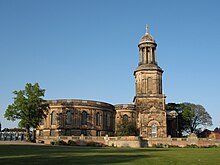St Chad's Church, Shrewsbury
| St Chad's Church, Shrewsbury | |
|---|---|

St Chad's Church, Shrewsbury, seen from The Quarry
|
|
| Location | St Chad's Terrace, Shrewsbury SY1 1JX |
| Country | United Kingdom |
| Denomination | Church of England |
| Website | www.stchadschurchshrewsbury.com |
| Architecture | |
| Heritage designation | Grade I |
| Designated | 10 January 1953 |
| Architect(s) | George Steuart |
| Years built | 1792 |
| Administration | |
| Diocese | Lichfield |
| Clergy | |
| Vicar(s) | Mark Chadwick |
St Chad's Church, Shrewsbury occupies a prominent position in the county town of Shropshire. The current church building was built in 1792, and with its distinctive round shape and high tower it is a well-known landmark in the town. It faces The Quarry area of parkland, which slopes down to the River Severn. The church is a Grade I listed building.
The motto of the church is "open doors, open hearts, and open minds". This indicates the aspiration of the church to be a welcoming church, involved in the community, and on a collective journey seeking after God.
Music is a strong tradition at St Chad's. The church has a robed choir which leads the music at many of the services. The church organ is a large three-manual pipe organ, built by Norman and Beard in 1904 and restored by Nicholsons in 1963 and Harrison & Harrison in 1985 and more recently in 2011. The church hosts lunchtime organ recitals and other concerts.
Charles Darwin was baptised in St Chad's church in 1809, and as a young boy attended the church with his mother Susannah.
The headstone prop of Ebenezer Scrooge (played by George C. Scott) that was used in the 1984 film A Christmas Carol is still present in the now-disused churchyard. According to the Shrewsbury Town Crier, Martin Wood, the headstone is not a "prop" but an actual period headstone, on which the original inscription had deteriorated to the point that the movie production people asked the church if they could use it and inscribe the "Ebenezer Scrooge" words on it. You can still see some of the original inscription on the bottom part of the stone. Among those actually buried in the churchyard was Shrewsbury architect Edward Haycock, Sr.
...
Wikipedia
